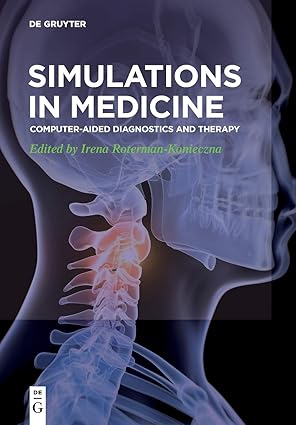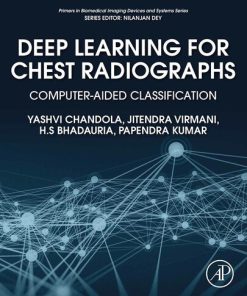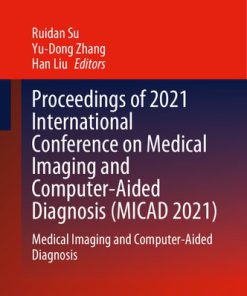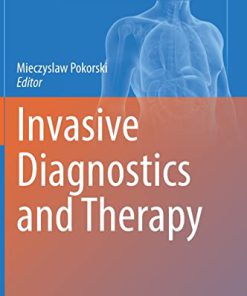Simulations in Medicine Computer aided Diagnostics and Therapy 1st Edition by Irena Roterman-Konieczna 3110666871 9783110666878
$50.00 Original price was: $50.00.$25.00Current price is: $25.00.
Simulations in Medicine Computer aided Diagnostics and Therapy 1st Edition Irena Roterman-Konieczna – Ebook Instant Download/Delivery ISBN(s): 9783110666878,3110666871

Product details:
- ISBN 10: 3110666871
- ISBN 13: 9783110666878
- Author: Irena Roterman-Konieczna
Modern practical medicine requires high tech in diagnostics and therapy and in consequence in education. All disciplines use computers to handle large data bases allowing individual therapy, to interpret large data bases in form of neuronal signals, help visualization of organs during surgery.
This book contains chapters on personalised therapy, advanced diagnostics in neurology, modern techniques like robotic surgery (da Vinci robots), 3D-printing and 3D-bioprinting, augmented reality applied in medical diagnostics and therapy. It is impossible without fast large scale data mining in both: clinical data interpretation as well as in hospital organization including hybrid surgery rooms and personal data flow.
The book is based on a course for medical students organized in the editor’s department. Every year, around 300 international undergraduate medical students take the course.
Table of content:
List of authors
Part I: Molecular level
1 Selected aspects of biological network analysis
1.1 Introduction
1.2 Selected biological databases
1.2.1 Case study: Gene Expression Omnibus
1.2.2 RegulonDB
1.3 Types of biological networks
1.3.1 Relations between molecules and types of networks
1.3.2 Biochemical pathways
1.4 Network development models
1.4.1 Selected tools for assembling networks on the basis of gene expression data
1.4.2 Selected tools for reconstruction of networks via literature mining
1.5 Network analysis
1.5.1 Selected tools
1.5.2 Cytoscape analysis examples
1.6 Summary
Part II: Cellular level
2 Negative feedback inhibition – Fundamental biological regulation in cells and organisms
2.1 Negative feedback-based systems simulations
2.1.1 Introduction
2.1.2 Glossary of Terms
2.1.3 Software model
2.1.4 Application manual
2.1.5 OS model example
2.1.6 Simulation algorithm
3 Information – A tool to interpret the biological phenomena
Part III: Organ level
4 The virtual heart
5 Modeling figure/ground separation with spiking neurons
5.1 Introduction
5.2 Figure/ground separation
5.3 Spiking neural networks
5.4 Lateral connections via gap junctions
5.5 Simulation of a sheet of laterally connected neurons
5.6 Basis of our model
5.7 Conclusion
Part IV: Whole body level
6 Simulation-based analysis of musculoskeletal system properties
6.1 Introduction
6.2 Components of a motion simulation model
6.2.1 Simulating the skeleton
6.2.2 Bone model simulations
6.2.3 Muscle models
6.2.4 Velocity-dependent simulations of the muscle model
6.3 Summary
6.4 Simulation software available for download
Part V: Diagnostics procedure
7 The world of virtual patients
7.1 Introduction
7.2 What are virtual patients?
7.3 Types of virtual patient
7.4 The motivation behind virtual patients
7.5 Theoretical underpinnings of virtual patients
7.5.1 Experiential learning theory
7.5.2 Theory of clinical reasoning
7.6 The technology behind virtual patients
7.6.1 Virtual patient systems
7.6.2 Components of virtual patients
7.6.3 Standards
7.7 Howto use virtual patients?
7.7.1 Preparation for or follow-up of face-to-face teaching
7.7.2 Integration into a face-to-face session
7.7.3 Assessment
7.7.4 Learning-by-teaching approach
7.8 The future of virtual patients
8 Interactive virtual patients in immersive clinical environments: The potential for learning
8.1 Introduction
8.2 What are virtual worlds?
8.3 Immersive Clinical Environments (Virtual Clinical Worlds)
8.4 Virtual patients
8.5 Interactive virtual patients in immersive clinical environments
8.6 Case study: Using immersive clinical environments for Inter-Professional Education at Charles R. Drew University of Medicine
8.6.1 Introduction to case study
8.6.2 The case study
8.6.3 Assessment
8.6.4 Summary and lessons learned
8.7 The potential for learning
8.7.1 Why choose immersive clinical environments?
8.7.2 Decide
8.7.3 Design
8.7.4 Develop
8.7.5 Deploy
8.8 Conclusion: “Learningby Doing… Together”
9 Melanoma thickness prediction
9.1 Introduction
9.2 Motivation
9.3 Clinical definition and importance
9.4 Algorithm for the determination of melanoma thickness
9.5 Melanoma thickness simulations
9.6 Conclusions
Part VI: Therapy
10 Simulating cancer chemotherapy
10.1 Simulating untreated cancer
10.2 Enhanced model of untreated cancer
10.3 Simulating chemotherapy
10.4 Simulation software available for the reader
11 Introduction to Reverse Engineering and Rapid Prototyping in medical applications
11.1 Introduction
11.2 Reverse Engineering
11.2.1 Phase one – Inputs of medical RE
11.2.2 Phase two – Data acquisition
11.2.3 Phase three – Data processing
11.2.4 Phase four – Biomedical applications
11.3 Software for medical RE
11.3.1 Mimics Innovation Suite
11.3.2 Simpleware ScanIP
11.3.3 3D-DOCTOR
11.3.4 Amira
11.3.5 Other software for 3D model reconstruction
11.3.6 RE and dimensional inspection
11.3.7 Freeform modeling
11.3.8 FEA simulation and CAD/CAM systems
11.4 Methods of Rapid Prototyping for medical applications – Additive Manufacturing
11.4.1 Liquid-based RP technology
11.4.2 Stereolithography (SLA)
11.4.3 Polymer printing and jetting
11.4.4 Digital Light Processing (DLP)
11.4.5 Solid sheet materials
11.4.6 Fused Deposition Modeling (FDM)
11.4.7 Selective Laser Sintering (SLS)
11.4.8 Selective Laser Melting (SLM)
11.4.9 Electron Beam Melting (EBM)
11.4.10 Tissue engineering
11.5 Case studies
11.5.1 One-stage pelvic tumor reconstruction
11.5.2 Orbital reconstruction following blowout fracture
11.6 Summary
12 Computer simulations in surgical education
12.1 Introduction
12.2 Overview of applications
12.2.1 Gray’s Anatomy Student Edition, Surgical Anatomy – Student Edition, digital editions of anatomy textbooks for the iOS (free) and Android (paid)
12.2.2 Essential Skeleton 4, Dental Patient Education Lite, 3D4Medical Images and Animations, free educational software by 3D4Medical.com, available for iOS, Android (Essential Skeleton 3 – earlier version; paid editions of Essential Anatomy 3 and iMuscle 2)
12.2.3 SpineDecide – An example of point of care patient education for healthcare professionals, available for iOS
12.2.4 iSurf BrainView – Virtual guide to the human brain, available for iOS
12.2.5 Monster Anatomy Lite – Knee – Orthopedic guide, available for iOS (Monster Minds Media)
12.2.6 AO Surgery Reference – Orthopedic guidebook for diagnosis and trauma treatment, available for iOS and Android
12.2.7 iOrtho+ – Educational aid for rehabilitationists, available for iOS and Android
12.2.8 DrawMD – Based on General Surgery and Thoracic Surgery by Visible Health Inc., available for iOS
12.2.9 MEDtube, available for iOS and Android
12.3 Specialized applications
12.3.1 Application description
12.4 Simulators
12.4.1 Selected examples of surgical simulators
12.5 Summary
Part VII: Support of therapy
13 From telemedicine to modeling and proactive medicine
13.1 Introduction
13.2 ICT-driven transformation in healthcare
13.2.1 Overview of telemedicine
13.2.2 Traditional model of healthcare supported by telemedicine
13.2.3 Modeling as knowledge representation in medicine
13.2.4 Towards a personalized and proactive approach in medicine
13.2.5 Model of proactive healthcare
13.3 Computational methods for models development
13.3.1 Computational methods for imaging data
13.3.2 Computational methods for parametric data
13.4 TeleCARE – telemonitoring framework
13.4.1 Overview
13.4.2 Contribution to the model-based proactive medicine concept
13.4.3 Case study
13.5 TeleDICOM – system for remote interactive consultations
13.5.1 Overview
13.5.2 Contribution to the model-based proactive medicine concept
13.6 Conclusions
14 Serious games in medicine
14.1 Serious games for health – Video games and health issues
14.1.1 Introduction
14.1.2 Previous surveys
14.1.3 Evidence review
14.1.4 Conclusions
14.2 Serious game graphic design based on understanding of a new model of visual perception – computer graphics
14.2.1 Introduction
14.2.2 A new model of perception for visual communication
14.2.3 Visibility enhancement with the use of animation
14.2.4 Conclusion
14.3 Serious gaming in medicine
14.3.1 Therapeutic support for children
14.3.2 Therapeutic support for the elderly
Index
Fußnoten
Read Less
People also search:
simulations in medicine computer aided diagnostics
computer-aided diagnosis in medical imaging
computer aided diagnostics
computer-aided detection and diagnosis in medical imaging
simulations in computer science
You may also like…
Computers - Computer Science
Uncategorized
Biology and other natural sciences - Genetics
Diagnostics and Gene Therapy for Human Genetic Disorders K. V. Chaitanya
Engineering - Computer Technology
Medicine - Therapy











